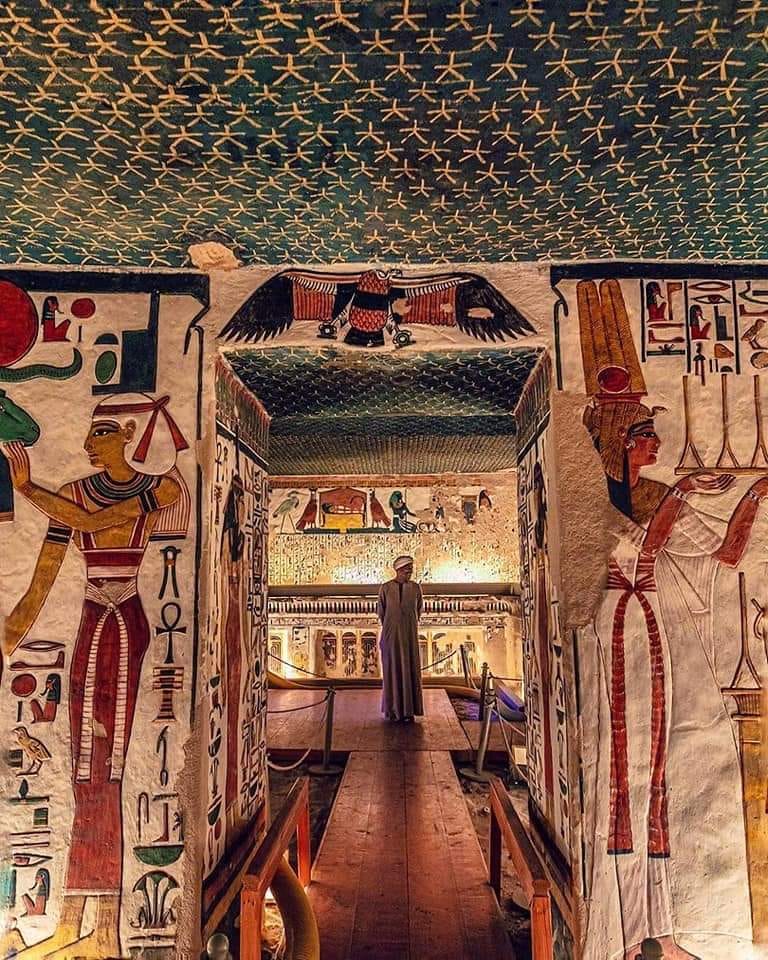Hidden deep within the Valley of the Queens lies one of the greatest treasures of ancient Egypt—a radiant symbol of love, power, and timeless artistry: the Tomb of Queen Nefertari. Often referred to as the “Sistine Chapel of Ancient Egypt,” this extraordinary burial site tells a story that has captivated scholars, archaeologists, and travelers for over a century. Its walls do more than hold the remains of a royal figure; they serve as a living testament to the grandeur of Egyptian civilization and the enduring bond between Queen Nefertari and her husband, Pharaoh Ramesses II.

The creation of this tomb was not just a royal duty—it was an intimate gesture of devotion. Ramesses II, one of Egypt’s most powerful and prolific pharaohs, commissioned this elaborate tomb for his beloved wife, Nefertari. Unlike other burial chambers of the era, where grandeur often served political or spiritual goals, Nefertari’s tomb resonates with personal affection. Every inch of its intricate wall carvings and vividly colored frescoes reflects the deep admiration and love Ramesses held for his queen. As the Great Royal Wife, Nefertari held a uniquely influential position. She was not merely a consort; she was an advisor, a diplomat, and a symbol of grace and wisdom. The tomb’s scale and beauty mirror her status, portraying her not only as a mortal queen but also as a divine figure worthy of reverence.
Though the tomb dates back more than 3,000 years, it remained hidden from modern eyes until 1904. That year, Italian archaeologist Ernesto Schiaparelli and his team discovered the burial site, uncovering what would become one of the most significant archaeological finds in Egypt’s long and layered history. Unlike many ancient tombs that had suffered the ravages of time, looting, and erosion, Nefertari’s tomb was remarkably well-preserved. This rare preservation allowed researchers and historians a detailed glimpse into the sophisticated burial customs of ancient Egypt, especially those reserved for the most elite figures. Moreover, the site shed new light on the prominent roles that royal women could occupy, a topic that continues to reshape our understanding of gender and power in antiquity.
The tomb’s true magnificence lies in its artistry. Step inside, and you are immediately surrounded by murals of breathtaking beauty and technical brilliance. The frescoes burst with color, their pigments still vibrant after more than three millennia. It’s not just the visual appeal that astounds; it’s the depth of meaning embedded within each scene. The walls portray Nefertari’s sacred journey through the afterlife, a voyage filled with divine encounters, spiritual trials, and celestial guidance. Gods and goddesses accompany her as she makes her way toward eternal life, each deity carefully illustrated with symbolic elements that reveal layers of religious and cultural significance.
What makes these paintings truly remarkable is their dual function: they are both spiritual tools and artistic masterpieces. In ancient Egyptian belief, the afterlife was not an abstract concept—it was a structured journey filled with challenges and rituals. The tomb’s walls show Nefertari engaged in these rites: offering prayers, presenting gifts, and invoking divine protection. Every image serves a purpose, each one selected to safeguard her soul as it passed through the various stages of the underworld. The precision with which these scenes were crafted reveals a society deeply invested in the spiritual wellbeing of its leaders. The tomb becomes, in essence, a visual guidebook to the afterlife—a sacred map painted in strokes of ochre, cobalt, and gold.
For today’s visitors, entering the Tomb of Nefertari is an experience akin to time travel. Carefully conserved and respectfully maintained, the site offers more than historical knowledge; it provides a profound emotional connection to the ancient world. To stand inside those sacred chambers, surrounded by artwork created by hands long since turned to dust, is to feel the continuity of human emotion and imagination across the ages. The silence inside the tomb is not empty—it is filled with the whispers of ceremony, devotion, and legacy.
This extraordinary site is not just about one queen or one era. It is a reflection of an entire civilization’s understanding of life, death, and the eternal bonds of love. Through the tomb’s artistic excellence and religious symbolism, we gain insight into how the ancient Egyptians viewed their world and what they believed awaited them beyond it. These beliefs are woven into every brushstroke and carved line, offering a narrative that bridges the gap between past and present.
Nefertari’s legacy, preserved within these hallowed walls, continues to inspire not only archaeologists and historians but also artists, spiritual thinkers, and everyday visitors from around the globe. Her tomb reminds us that ancient Egypt was not a land solely of pharaohs and pyramids, but also of love stories, cultural sophistication, and extraordinary individuals who left lasting impressions on the world.
In many ways, the Tomb of Nefertari transcends its function as a burial site. It serves as a cultural monument, a masterpiece of ancient art, and a symbol of the spiritual aspirations of an entire society. It captures the essence of a time when art, religion, and power were intricately intertwined. Most importantly, it tells the story of a woman who, through her strength, grace, and enduring relationship with one of history’s most legendary rulers, secured a place in the hearts of generations to come.
The tomb remains one of Egypt’s most treasured sites, not merely for its aesthetic and historical value but for what it represents: a society capable of remarkable creativity, profound belief, and deep emotional expression. As long as its walls continue to speak, the story of Nefertari—and the civilization that honored her—will never be forgotten.





